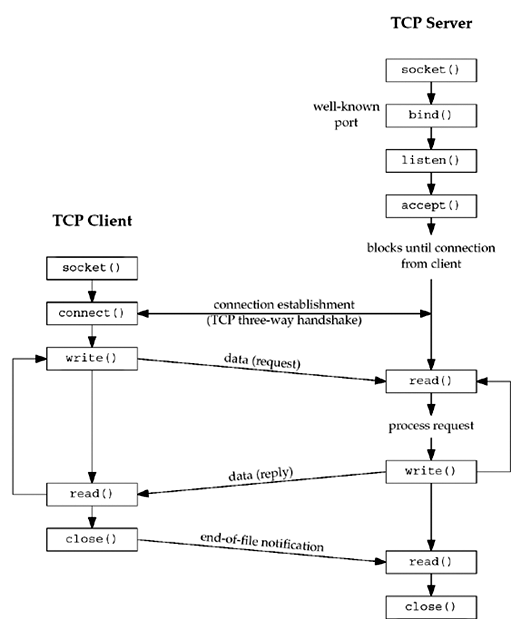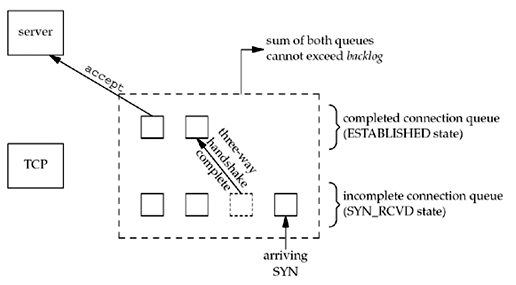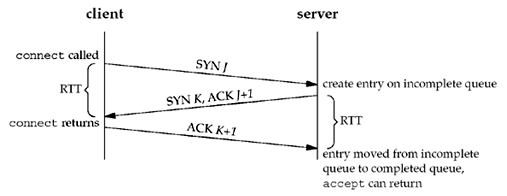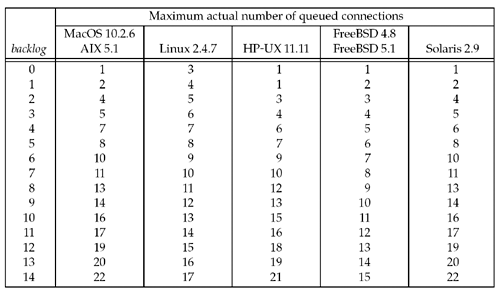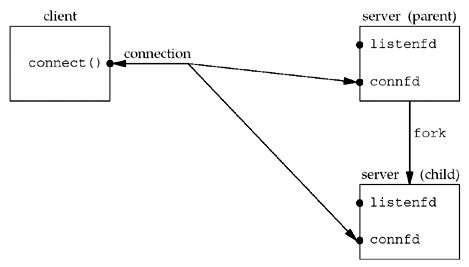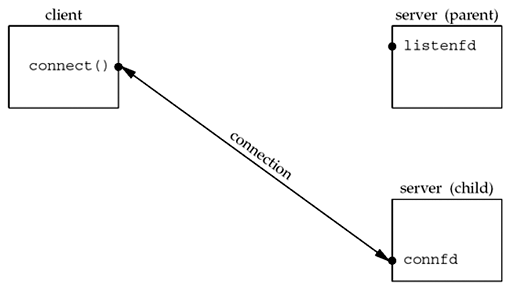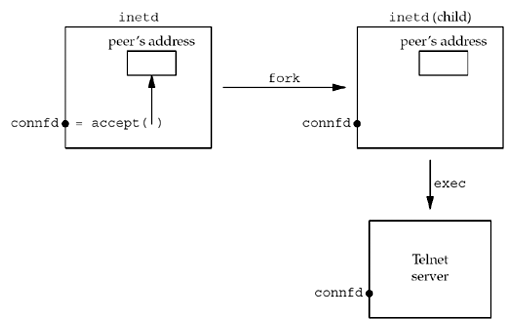Chapter 4. Elementary TCP Sockets¶
In C, we cannot represent a constant structure on the right-hand side of an assignment. UNP
Introduction¶
This chapter describes the elementary socket functions required to write a complete TCP client and server, along with concurrent servers, a common Unix technique for providing concurrency when numerous clients are connected to the same server at the same time. Each client connection causes the server to fork a new process just for that client. In this chapter, we consider only the one-process-per-client model using fork.
The figure below shows a timeline of the typical scenario that takes place between a TCP client and server. First, the server is started, then sometime later, a client is started that connects to the server. We assume that the client sends a request to the server, the server processes the request, and the server sends a reply back to the client. This continues until the client closes its end of the connection, which sends an end-of-file notification to the server. The server then closes its end of the connection and either terminates or waits for a new client connection.
socket Function¶
To perform network I/O, the first thing a process must do is call the socket function, specifying the type of communication protocol desired (TCP using IPv4, UDP using IPv6, Unix domain stream protocol, etc.).
#include <sys/socket.h> int socket (int family, int type, int protocol); /* Returns: non-negative descriptor if OK, -1 on error */
Arguments:
-
family specifies the protocol family and is one of the constants in the table below. This argument is often referred to as domain instead of family.
family Description AF_INETIPv4 protocols AF_INET6IPv6 protocols AF_LOCALUnix domain protocols (Chapter 15) AF_ROUTERouting sockets (Chapter 18) AF_KEYKey socket (Chapter 19) -
The socket type is one of the constants shown in table below:
type Description SOCK_STREAMstream socket SOCK_DGRAMdatagram socket SOCK_SEQPACKETsequenced packet socket SOCK_RAWraw socket -
The protocol argument to the
socketfunction should be set to the specific protocol type found in the table below, or 0 to select the system's default for the given combination of family and type.protocol Description IPPROTO_TCPTCP transport protocol IPPROTO_UDPUDP transport protocol IPPROTO_SCTPSCTP transport protocol
Not all combinations of socket family and type are valid. The table below shows the valid combinations, along with the actual protocols that are valid for each pair. The boxes marked "Yes" are valid but do not have handy acronyms. The blank boxes are not supported.
AF_INET |
AF_INET6 |
AF_LOCAL |
AF_ROUTE |
AF_KEY |
|
SOCK_STREAM |
TCP/SCTP | TCP/SCTP | Yes | ||
SOCK_DGRAM |
UDP | UDP | Yes | ||
SOCK_SEQPACKET |
SCTP | SCTP | Yes | ||
SOCK_RAW |
IPv4 | IPv6 | Yes | Yes |
Notes:
- You may also encounter the corresponding
PF_xxx constant as the first argument to socket. This is discussed in the next section in this Chapter. - You may encounter
AF_UNIX(the historical Unix name) instead ofAF_LOCAL(the POSIX name). This is discussed in Chapter 15. - Linux supports a new socket type,
SOCK_PACKET, that provides access to the datalink, similar to BPF and DLPI (Section 2.2). This is discussed in Chapter 29 - The key socket,
AF_KEY, is newer than the others. It provides support for cryptographic security. Similar to the way that a routing socket (AF_ROUTE) is an interface to the kernel's routing table, the key socket is an interface into the kernel's key table. This is discussed in Chapter 19.
On success, the socket function returns a small non-negative integer value, similar to a file descriptor. We call this a socket descriptor, or a sockfd. To obtain this socket descriptor, all we have specified is a protocol family (IPv4, IPv6, or Unix) and the socket type (stream, datagram, or raw). We have not yet specified either the local protocol address or the foreign protocol address.
AF_xxx Versus PF_xxx¶
The "AF_" prefix stands for "address family" and the "PF_" prefix stands for "protocol family." Historically, the intent was that a single protocol family might support multiple address families and that the PF_ value was used to create the socket and the AF_ value was used in socket address structures. But in actuality, a protocol family supporting multiple address families has never been supported and the <sys/socket.h> header defines the PF_ value for a given protocol to be equal to the AF_ value for that protocol. While there is no guarantee that this equality between the two will always be true, should anyone change this for existing protocols, lots of existing code would break.
To conform to existing coding practice, we use only the AF_ constants in this text, although you may encounter the PF_ value, mainly in calls to socket.
[p98-99]
connect Function¶
The connect function is used by a TCP client to establish a connection with a TCP server.
#include <sys/socket.h> int connect(int sockfd, const struct sockaddr *servaddr, socklen_t addrlen); /* Returns: 0 if OK, -1 on error */
- sockfd is a socket descriptor returned by the
socketfunction. - The servaddr and addrlen arguments are a pointer to a socket address structure (which contains the IP address and port number of the server) and its size. (Section 3.3)
The client does not have to call bind before calling connect: the kernel will choose both an ephemeral port and the source IP address if necessary.
In the case of a TCP socket, the connect function initiates TCP's three-way handshake (Section 2.6). The function returns only when the connection is established or an error occurs. There are several different error returns possible:
- If the client TCP receives no response to its SYN segment,
ETIMEDOUTis returned.- For example, in 4.4BSD, the client sends one SYN when
connectis called, sends another SYN 6 seconds later, and sends another SYN 24 seconds later. If no response is received after a total of 75 seconds, the error is returned. - Some systems provide administrative control over this timeout.
- For example, in 4.4BSD, the client sends one SYN when
- If the server's response to the client's SYN is a reset (RST), this indicates that no process is waiting for connections on the server host at the port specified (the server process is probably not running). This is a hard error and the error
ECONNREFUSEDis returned to the client as soon as the RST is received. An RST is a type of TCP segment that is sent by TCP when something is wrong. Three conditions that generate an RST are:- When a SYN arrives for a port that has no listening server.
- When TCP wants to abort an existing connection.
- When TCP receives a segment for a connection that does not exist.
- If the client's SYN elicits an ICMP "destination unreachable" from some intermediate router, this is considered a soft error. The client kernel saves the message but keeps sending SYNs with the same time between each SYN as in the first scenario. If no response is received after some fixed amount of time (75 seconds for 4.4BSD), the saved ICMP error is returned to the process as either
EHOSTUNREACHorENETUNREACH. It is also possible that the remote system is not reachable by any route in the local system's forwarding table, or that theconnectcall returns without waiting at all. Note that network unreachables are considered obsolete, and applications should just treatENETUNREACHandEHOSTUNREACHas the same error.
Example: nonexistent host on the local subnet *¶
We run the client daytimetcpcli (Figure 1.5) and specify an IP address that is on the local subnet (192.168.1/24) but the host ID (100) is nonexistent. When the client host sends out ARP requests (asking for that host to respond with its hardware address), it will never receive an ARP reply.
solaris % daytimetcpcli 192.168.1.100 connect error: Connection timed out
We only get the error after the connect times out. Notice that our err_sys function prints the human-readable string associated with the ETIMEDOUT error.
Example: no server process running *¶
We specify a host (a local router) that is not running a daytime server:
solaris % daytimetcpcli 192.168.1.5 connect error: Connection refused
The server responds immediately with an RST.
Example: destination not reachable on the Internet *¶
Our final example specifies an IP address that is not reachable on the Internet. If we watch the packets with tcpdump, we see that a router six hops away returns an ICMP host unreachable error.
solaris % daytimetcpcli 192.3.4.5 connect error: No route to host
As with the ETIMEDOUT error, connect returns the EHOSTUNREACH error only after waiting its specified amount of time.
In terms of the TCP state transition diagram (Figure 2.4):
connectmoves from the CLOSED state (the state in which a socket begins when it is created by thesocketfunction) to the SYN_SENT state, and then, on success, to the ESTABLISHED state.- If
connectfails, the socket is no longer usable and must be closed. We cannot callconnectagain on the socket.
In Figure 11.10, we will see that when we call connect in a loop, trying each IP address for a given host until one works, each time connect fails, we must close the socket descriptor and call socket again.
bind Function¶
The bind function assigns a local protocol address to a socket. The protocol address is the combination of either a 32-bit IPv4 address or a 128-bit IPv6 address, along with a 16-bit TCP or UDP port number.
#include <sys/socket.h> int bind (int sockfd, const struct sockaddr *myaddr, socklen_t addrlen); /* Returns: 0 if OK,-1 on error */
- The second argument myaddr is a pointer to a protocol-specific addres
- The third argument addrlen is the size of this address structure.
With TCP, calling bind lets us specify a port number, an IP address, both, or neither.
-
Servers bind their well-known port when they start. (Figure 1.9) If a TCP client or server does not do this, the kernel chooses an ephemeral port for the socket when either
connectorlistenis called.- It is normal for a TCP client to let the kernel choose an ephemeral port, unless the application requires a reserved port (Figure 2.10)
- However, it is rare for a TCP server to let the kernel choose an ephemeral port, since servers are known by their well-known port.
Exceptions to this rule are Remote Procedure Call (RPC) servers. They normally let the kernel choose an ephemeral port for their listening socket since this port is then registered with the RPC port mapper. Clients have to contact the port mapper to obtain the ephemeral port before they can connect to the server. This also applies to RPC servers using UDP.
-
A process can bind a specific IP address to its socket. The IP address must belong to an interface on the host.
- For a TCP client, this assigns the source IP address that will be used for IP datagrams sent on the socket. Normally, a TCP client does not
bindan IP address to its socket. The kernel chooses the source IP address when the socket is connected, based on the outgoing interface that is used, which in turn is based on the route required to reach the server - For a TCP server, this restricts the socket to receive incoming client connections destined only to that IP address. If a TCP server does not
bindan IP address to its socket, the kernel uses the destination IP address of the client's SYN as the server's source IP address.
- For a TCP client, this assigns the source IP address that will be used for IP datagrams sent on the socket. Normally, a TCP client does not
As mentioned, calling bind lets us specify the IP address, the port, both, or neither. The following table summarizes the values to which we set sin_addr and sin_port, or sin6_addr and sin6_port, depending on the desired result.
| IP address | Port | Result |
|---|---|---|
| Wildcard | 0 | Kernel chooses IP address and port |
| Wildcard | nonzero | Kernel chooses IP address, process specifies port |
| Local IP address | 0 | Process specifies IP address, kernel chooses port |
| Local IP address | nonzero | Process specifies IP address and port |
- If we specify a port number of 0, the kernel chooses an ephemeral port when
bindis called. - If we specify a wildcard IP address, the kernel does not choose the local IP address until either the socket is connected (TCP) or a datagram is sent on the socket (UDP).
Wildcard Address and INADDR_ANY *¶
With IPv4, the wildcard address is specified by the constant INADDR_ANY, whose value is normally 0. This tells the kernel to choose the IP address. Figure 1.9 has the assignment:
struct sockaddr_in servaddr; servaddr.sin_addr.s_addr = htonl (INADDR_ANY); /* wildcard */
While this works with IPv4, where an IP address is a 32-bit value that can be represented as a simple numeric constant (0 in this case), we cannot use this technique with IPv6, since the 128-bit IPv6 address is stored in a structure. In C we cannot represent a constant structure on the right-hand side of an assignment. To solve this problem, we write:
struct sockaddr_in6 serv; serv.sin6_addr = in6addr_any; /* wildcard */
The system allocates and initializes the in6addr_any variable to the constant IN6ADDR_ANY_INIT. The <netinet/in.h> header contains the extern declaration for in6addr_any.
The value of INADDR_ANY (0) is the same in either network or host byte order, so the use of htonl is not really required. But, since all the INADDR_constants defined by the <netinet/in.h> header are defined in host byte order, we should use htonl with any of these constants.
If we tell the kernel to choose an ephemeral port number for our socket (by specifying a 0 for port number), bind does not return the chosen value. It cannot return this value since the second argument to bind has the const qualifier. To obtain the value of the ephemeral port assigned by the kernel, we must call getsockname to return the protocol address.
Binding a non-wildcard IP address *¶
A common example of a process binding a non-wildcard IP address to a socket is a host that provides Web servers to multiple organizations:
- First, each organization has its own domain name, such as www.organization.com.
- Next, each organization's domain name maps into a different IP address, but typically on the same subnet.
For example, if the subnet is 198.69.10, the first organization's IP address could be 198.69.10.128, the next 198.69.10.129, and so on. All these IP addresses are then aliased onto a single network interface (using the alias option of the ifconfig command on 4.4BSD, for example) so that the IP layer will accept incoming datagrams destined for any of the aliased addresses. Finally, one copy of the HTTP server is started for each organization and each copy binds only the IP address for that organization.
An alternative technique is to run a single server that binds the wildcard address. When a connection arrives, the server calls getsockname to obtain the destination IP address from the client, which in our discussion above could be 198.69.10.128, 198.69.10.129, and so on. The server then handles the client request based on the IP address to which the connection was issued.
One advantage in binding a non-wildcard IP address is that the demultiplexing of a given destination IP address to a given server process is then done by the kernel.
We must be careful to distinguish between the interface on which a packet arrives versus the destination IP address of that packet. In Section 8.8, we will talk about the weak end system model and the strong end system model. Most implementations employ the former, meaning it is okay for a packet to arrive with a destination IP address that identifies an interface other than the interface on which the packet arrives. (This assumes a multihomed host.) Binding a non-wildcard IP address restricts the datagrams that will be delivered to the socket based only on the destination IP address. It says nothing about the arriving interface, unless the host employs the strong end system model.
A common error from bind is EADDRINUSE ("Address already in use"), which is detailed in Section 7.5 when discussing the SO_REUSEADDR and SO_REUSEPORT socket options.
listen Function¶
The listen function is called only by a TCP server and it performs two actions:
- The
listenfunction converts an unconnected socket into a passive socket, indicating that the kernel should accept incoming connection requests directed to this socket. In terms of the TCP state transition diagram (Figure 2.4), the call tolistenmoves the socket from the CLOSED state to the LISTEN state.- When a socket is created by the
socketfunction (and before callinglisten), it is assumed to be an active socket, that is, a client socket that will issue aconnect.
- When a socket is created by the
- The second argument backlog to this function specifies the maximum number of connections the kernel should queue for this socket.
This function is normally called after both the socket and bind functions and must be called before calling the accept function.
Connection queues *¶
To understand the backlog argument, we must realize that for a given listening socket, the kernel maintains two queues:
- An incomplete connection queue, which contains an entry for each SYN that has arrived from a client for which the server is awaiting completion of the TCP three-way handshake. These sockets are in the
SYN_RCVDstate (Figure 2.4). - A completed connection queue, which contains an entry for each client with whom the TCP three-way handshake has completed. These sockets are in the ESTABLISHED state (Figure 2.4).
These two queues are depicted in the figure below:
When an entry is created on the incomplete queue, the parameters from the listen socket are copied over to the newly created connection. The connection creation mechanism is completely automatic; the server process is not involved.
Packet exchanges during conenction establishment *¶
The following figure depicts the packets exchanged during the connection establishment with these two queues:
- When a SYN arrives from a client, TCP creates a new entry on the incomplete queue and then responds with the second segment of the three-way handshake: the server's SYN with an ACK of the client's SYN (Section 2.6).
- This entry will remain on the incomplete queue, until:
- The third segment of the three-way handshake arrives (the client's ACK of the server's SYN), or
- The entry times out. (Berkeley-derived implementations have a timeout of 75 seconds for these incomplete entries.)
- If the three-way handshake completes normally, the entry moves from the incomplete queue to the end of the completed queue.
- When the process calls
accept:- The first entry on the completed queue is returned to the process, or
- If the queue is empty, the process is put to sleep until an entry is placed onto the completed queue.
The backlog argument *¶
Several points to consider when handling the two queues:
- Sum of both queues. The backlog argument to the
listenfunction has historically specified the maximum value for the sum of both queues. - Multiplied by 1.5. Berkeley-derived implementations add a fudge factor to the backlog: It is multiplied by 1.5.
- If the backlog specifies the maximum number of completed connections the kernel will queue for a socket, then the reason for the fudge factor is to take into account incomplete connections on the queue.
- Do not specify value of 0 for backlog, as different implementations interpret this differently (Figure 4.10). If you do not want any clients connecting to your listening socket, close the listening socket.
- One RTT. If the three-way handshake completes normally (no lost segments and no retransmissions), an entry remains on the incomplete connection queue for one RTT.
- Configurable maximum value. Many current systems allow the administrator to modify the maximum value for the backlog. Historically, sample code always shows a backlog of 5 (which is adequate today).
- What value should the application specify for the backlog (5 is often inadequate)? There is no easy answer to this.
- HTTP servers now specify a larger value, but if the value specified is a constant in the source code, to increase the constant requires recompiling the server.
- Another method is to allow a command-line option or an environment variable to override the default. It is always acceptable to specify a value that is larger than supported by the kernel, as the kernel should silently truncate the value to the maximum value that it supports, without returning an error. The following example is the wrapper function for
listenwhich allows the environment variableLISTENQto override the value specified by the caller:
void Listen(int fd, int backlog) { char *ptr; /* can override 2nd argument with environment variable */ if ( (ptr = getenv("LISTENQ")) != NULL) backlog = atoi(ptr); if (listen(fd, backlog) < 0) err_sys("listen error"); } /* end Listen */
- Fixed number of connections. Historically the reason for queuing a fixed number of connections is to handle the case of the server process being busy between successive calls to
accept. This implies that of the two queues, the completed queue should normally have more entries than the incomplete queue. Again, busy Web servers have shown that this is false. The reason for specifying a large backlog is because the incomplete connection queue can grow as client SYNs arrive, waiting for completion of the three-way handshake. - No RST sent if queues are full. If the queues are full when a client SYN arrives, TCP ignores the arriving SYN; it does not send an RST. This is because the condition is considered temporary, and the client TCP will retransmit its SYN, hopefully finding room on the queue in the near future. If the server TCP immediately responded with an RST, the client's
connectwould return an error, forcing the application to handle this condition instead of letting TCP's normal retransmission take over. Also, the client could not differentiate between an RST in response to a SYN meaning "there is no server at this port" versus "there is a server at this port but its queues are full." - Data queued in the socket's receive buffer. Data that arrives after the three-way handshake completes, but before the server calls
accept, should be queued by the server TCP, up to the size of the connected socket's receive buffer.
The following figure shows actual number of queued connections for values of backlog:
SYN Flooding *¶
SYN flooding is a type of attack (the attacker writes a program to send SYNs at a high rate to the victim) that attempts to fill the incomplete connection queue for one or more TCP ports. Additionally, the source IP address of each SYN is set to a random number (called IP spoofing) so that the server's SYN/ACK goes nowhere.This also prevents the server from knowing the real IP address of the attacker. By filling the incomplete queue with bogus SYNs, legitimate SYNs are not queued, providing a denial of service to legitimate clients.
The listen's backlog argument should specify the maximum number of completed connections for a given socket that the kernel will queue. The purpose ofto limit completed connections is to stop the kernel from accepting new connection requests for a given socket when the application is not accepting them. If a system implements this interpretation, then the application need not specify huge backlog values just because the server handles lots of client requests or to provide protection against SYN flooding. The kernel handles lots of incomplete connections, regardless of whether they are legitimate or from a hacker. But even with this interpretation, scenarios do occur where the traditional value of 5 is inadequate.
accept Function¶
accept is called by a TCP server to return the next completed connection from the front of the completed connection queue (Figure 4.7). If the completed connection queue is empty, the process is put to sleep (assuming the default of a blocking socket).
#include <sys/socket.h> int accept (int sockfd, struct sockaddr *cliaddr, socklen_t *addrlen); /* Returns: non-negative descriptor if OK, -1 on error */
The cliaddr and addrlen arguments are used to return the protocol address of the connected peer process (the client). addrlen is a value-result argument (Section 3.3):
- Before the call, we set the integer value referenced by *addrlen to the size of the socket address structure pointed to by cliaddr;
- On return, this integer value contains the actual number of bytes stored by the kernel in the socket address structure.
If successful, accept returns a new descriptor automatically created by the kernel. This new descriptor refers to the TCP connection with the client.
- The listening socket is the first argument (sockfd) to
accept(the descriptor created bysocketand used as the first argument to bothbindandlisten). - The connected socket is the return value from
acceptthe connected socket.
It is important to differentiate between these two sockets:
- A given server normally creates only one listening socket, which then exists for the lifetime of the server.
- The kernel creates one connected socket for each client connection that is accepted (for which the TCP three-way handshake completes).
- When the server is finished serving a given client, the connected socket is closed.
This function returns up to three values:
- An integer return code that is either a new socket descriptor or an error indication,
- The protocol address of the client process (through the cliaddr pointer),
- The size of this address (through the addrlen pointer).
If we are not interested in having the protocol address of the client returned, we set both cliaddr and addrlen to null pointers. See intro/daytimetcpsrv.c.
Example: Value-Result Arguments¶
The following code shows how to handle the value-result argument to accept by modifying the code from intro/daytimetcpsrv.c to print the IP address and port of the client:
#include "unp.h" #include <time.h> int main(int argc, char **argv) { int listenfd, connfd; socklen_t len; struct sockaddr_in servaddr, cliaddr; char buff[MAXLINE]; time_t ticks; listenfd = Socket(AF_INET, SOCK_STREAM, 0); bzero(&servaddr, sizeof(servaddr)); servaddr.sin_family = AF_INET; servaddr.sin_addr.s_addr = htonl(INADDR_ANY); servaddr.sin_port = htons(13); /* daytime server */ Bind(listenfd, (SA *) &servaddr, sizeof(servaddr)); Listen(listenfd, LISTENQ); for ( ; ; ) { len = sizeof(cliaddr); connfd = Accept(listenfd, (SA *) &cliaddr, &len); printf("connection from %s, port %d\n", Inet_ntop(AF_INET, &cliaddr.sin_addr, buff, sizeof(buff)), ntohs(cliaddr.sin_port)); ticks = time(NULL); snprintf(buff, sizeof(buff), "%.24s\r\n", ctime(&ticks)); Write(connfd, buff, strlen(buff)); Close(connfd); } }
This program does the following:
- New declarations. Two new variables are defined:
lenwill be a value-result variable.cliaddrwill contain the client's protocol address.
- Accept connection and print client's address.
- Initialize
lento the size of the socket address structure - Pass a pointer to the
cliaddrstructure and a pointer tolenas the second and third arguments to accept. - Call
inet_ntop(Section 3.7) to convert the 32-bit IP address in the socket address structure to a dotted-decimal ASCII string and callntohs(Section 3.4) to convert the 16-bit port number from network byte order to host byte order.
- Initialize
Run this new server and then run our client on the same host, connecting to our server twice in a row:
solaris % daytimetcpcli 127.0.0.1 Thu Sep 11 12:44:00 2003 solaris % daytimetcpcli 192.168.1.20 Thu Sep 11 12:44:09 2003
We first specify the server's IP address as the loopback address (127.0.0.1) and then as its own IP address (192.168.1.20). Here is the corresponding server output:
solaris # daytimetcpsrv1 connection from 127.0.0.1, port 43388 connection from 192.168.1.20, port 43389
Since our daytime client (Figure 1.5) does not call bind, the kernel chooses the source IP address based on the outgoing interface that is used (Section 4.4).
- In the first case, the kernel sets the source IP address to the loopback address;
- In the second case, it sets the address to the IP address of the Ethernet interface.
We can also see in this example that the ephemeral port chosen by the Solaris kernel is 43388, and then 43389
The pound sign (#) as the shell prompt indicates that our server must run with superuser privileges to bind the reserved port of 13. If we do not have superuser privileges, the call to bind will fail:
solaris % daytimetcpsrv1 bind error: Permission denied
fork and exec Functions¶
Concurrent Servers¶
The server described in intro/daytimetcpsrv1.c is an iterative server. But when a client request can take longer to service, we do not want to tie up a single server with one client; we want to handle multiple clients at the same time. The simplest way to write a concurrent server under Unix is to fork a child process to handle each client.
The following code shows the outline for a typical concurrent server:
pid_t pid; int listenfd, connfd; listenfd = Socket( ... ); /* fill in sockaddr_in{} with server's well-known port */ Bind(listenfd, ... ); Listen(listenfd, LISTENQ); for ( ; ; ) { connfd = Accept (listenfd, ... ); /* probably blocks */ if( (pid = Fork()) == 0) { Close(listenfd); /* child closes listening socket */ doit(connfd); /* process the request */ Close(connfd); /* done with this client */ exit(0); /* child terminates */ } Close(connfd); /* parent closes connected socket */ }
- When a connection is established,
acceptreturns, the server calls fork, and the child process services the client (onconnfd, the connected socket) and the parent process waits for another connection (onlistenfd, the listening socket). The parent closes the connected socket since the child handles the new client. - We assume that the function
doitdoes whatever is required to service the client. When this function returns, we explicitlyclosethe connected socket in the child. This is not required since the next statement callsexit, and part of process termination is to close all open descriptors by the kernel. Whether to include this explicit call tocloseor not is a matter of personal programming taste.
Reference count of sockets *¶
Calling close on a TCP socket causes a FIN to be sent, followed by the normal TCP connection termination sequence. Why doesn't the close of connfd by the parent terminate its connection with the client? To understand what's happening, we must understand that every file or socket has a reference count. The reference count is maintained in the file table entry. This is a count of the number of descriptors that are currently open that refer to this file or socket. In the above code:
- After
socketreturns, the file table entry associated withlistenfdhas a reference count of 1. - After
acceptreturns, the file table entry associated withconnfdhas a reference count of 1. - But, after
forkreturns, both descriptors are shared (duplicated) between the parent and child, so the file table entries associated with both sockets now have a reference count of 2. Therefore, when the parent closesconnfd, it just decrements the reference count from 2 to 1 and that is all. - The actual cleanup and de-allocation of the socket does not happen until the reference count reaches 0. This will occur at some time later when the child closes
connfd.
Visualizing the sockets and connection *¶
The following figures visualize the sockets and connection in the code above:
Before call to accept returns, the server is blocked in the call to accept and the connection request arrives from the client:
Ater return from accept, the connection is accepted by the kernel and a new socket connfd is created (this is a connected socket and data can now be read and written across the connection):
After fork returns, both descriptors, listenfd and connfd, are shared (duplicated) between the parent and child:
After the parent closes the connected socket and the child closes the listening socket:
This is the desired final state of the sockets. The child is handling the connection with the client and the parent can call accept again on the listening socket, to handle the next client connection.
close Function¶
The normal Unix close function is also used to close a socket and terminate a TCP connection.
#include <unistd.h> int close (int sockfd); /* Returns: 0 if OK, -1 on error */
The default action of close with a TCP socket is to mark the socket as closed and return to the process immediately. The socket descriptor is no longer usable by the process: It cannot be used as an argument to read or write. But, TCP will try to send any data that is already queued to be sent to the other end, and after this occurs, the normal TCP connection termination sequence takes place.
SO_LINGER socket option (detailed in Section 7.5) lets us change this default action with a TCP socket.
Descriptor Reference Counts¶
As mentioned in end of Section 4.8, when the parent process in our concurrent server closes the connected socket, this just decrements the reference count for the descriptor. Since the reference count was still greater than 0, this call to close did not initiate TCP's four-packet connection termination sequence. This is the behavior we want with our concurrent server with the connected socket that is shared between the parent and child.
If we really want to send a FIN on a TCP connection, the shutdown function can be used (Section 6.6) instead of close.
Be aware if the parent does not call close for each connected socket returned by accept:
- The parent will eventually run out of descriptors (there is usually a limit to the number of descriptors that any process can have open at any time)
- None of the client connections will be terminated. When the child closes the connected socket, its reference count will go from 2 to 1 and it will remain at 1 since the parent never
closes the connected socket. This will prevent TCP's connection termination sequence from occurring, and the connection will remain open.
getsockname and getpeername Functions¶
getsocknamereturns the local protocol address associated with a socket.getpeernamereturns the foreign protocol address associated with a socket.
#include <sys/socket.h> int getsockname(int sockfd, struct sockaddr *localaddr, socklen_t *addrlen); int getpeername(int sockfd, struct sockaddr *peeraddr, socklen_t *addrlen); /* Both return: 0 if OK, -1 on error */
The addrlen argument for both functions is value-result argument: both functions fill in the socket address structure pointed to by localaddr or peeraddr.
The term "name" in the function name is misleading. These two functions return the protocol address associated with one of the two ends of a network connection, which for IPV4 and IPV6 is the combination of an IP address and port number. These functions have nothing to do with domain names.
These two functions are required for the following reasons:
- After
connectsuccessfully returns in a TCP client that does not callbind,getsocknamereturns the local IP address and local port number assigned to the connection by the kernel. - After calling
bindwith a port number of 0 (telling the kernel to choose the local port number),getsocknamereturns the local port number that was assigned. getsocknamecan be called to obtain the address family of a socket.- In a TCP server that
binds the wildcard IP address (intro/daytimetcpsrv.c), once a connection is established with a client (acceptreturns successfully), the server can callgetsocknameto obtain the local IP address assigned to the connection. The socket descriptor argument togetsocknamemust be that of the connected socket, and not the listening socket. - When a server is
execed by the process that callsaccept, the only way the server can obtain the identity of the client is to callgetpeername. For example,inetdforks andexecs a TCP server (follwing figure):inetdcallsaccept, which return two values: the connected socket descriptor (connfd, return value of the function) and the "peer's address" (an Internet socket address structure) that contains the IP address and port number of the client.forkis called and a child ofinetdis created, with a copy of the parent's memory image, so the socket address structure is available to the child, as is the connected socket descriptor (since the descriptors are shared between the parent and child).- When the child
execs the real server (e.g. Telnet server that we show), the memory image of the child is replaced with the new program file for the Telnet server (the socket address structure containing the peer's address is lost), and the connected socket descriptor remains open across theexec. One of the first function calls performed by the Telnet server isgetpeernameto obtain the IP address and port number of the client.
In this example, the Telnet server must know the value of connfd when it starts. There are two common ways to do this.
- The process calling
execpass it as a command-line argument to the newlyexeced program. - A convention can be established that a certain descriptor is always set to the connected socket before calling
exec.
The second one is what inetd does, always setting descriptors 0, 1, and 2 to be the connected socket.
Example: Obtaining the Address Family of a Socket¶
The sockfd_to_family function shown in the code below returns the address family of a socket.
int sockfd_to_family(int sockfd) { struct sockaddr_storage ss; socklen_t len; len = sizeof(ss); if (getsockname(sockfd, (SA *) &ss, &len) < 0) return(-1); return(ss.ss_family); }
This program does the following:
- Allocate room for largest socket address structure. Since we do not know what type of socket address structure to allocate, we use a sockaddr_storage value, since it can hold any socket address structure supported by the system.
- Call
getsockname. We callgetsocknameand return the address family. The POSIX specification allows a call togetsocknameon an unbound socket.
